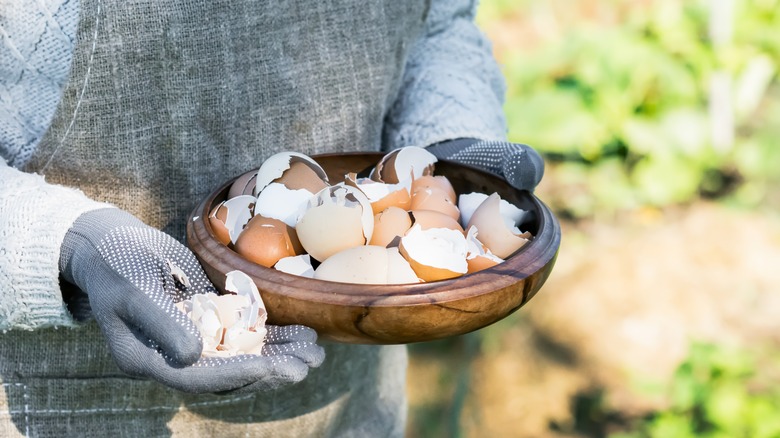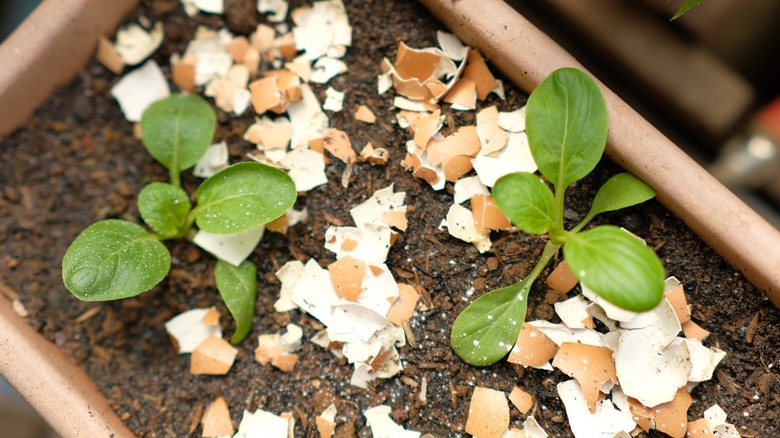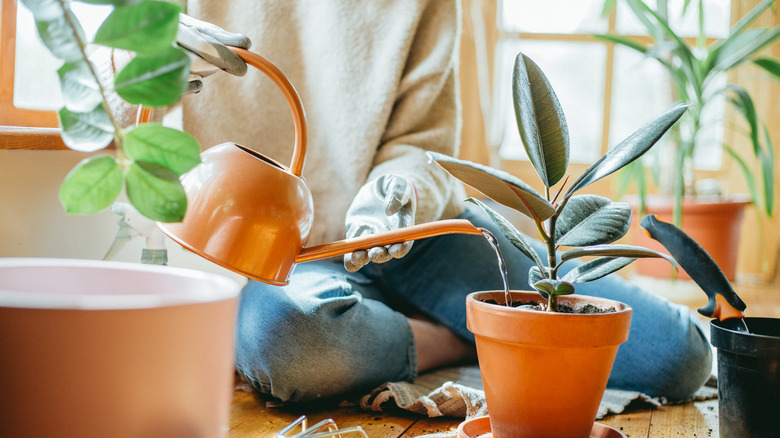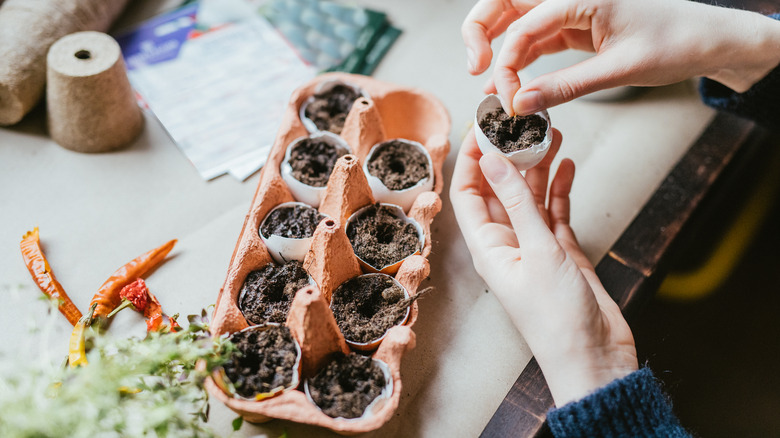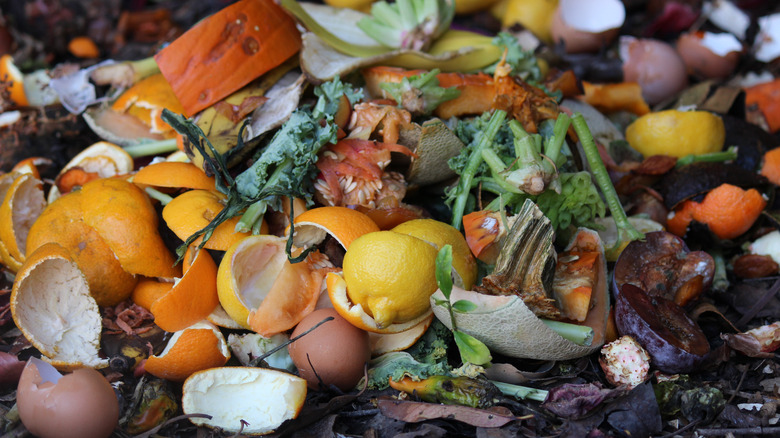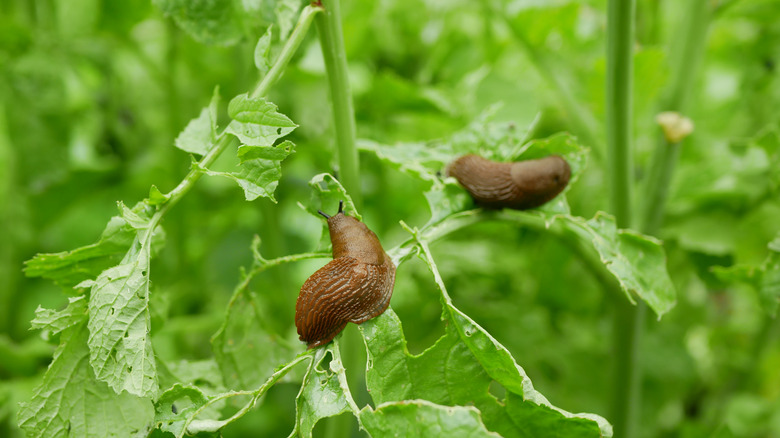Unexpected Uses For Eggshells In Your Garden
Eggs are one of the most nutrient-dense foods around and despite getting some bad press in the past concerning high cholesterol, today they are considered a superfood and are a healthy addition to the diet of most people. So, it makes sense then that — like eggs — eggshells contain beneficial nutrients. However, because no one really wants to eat eggshells (even though they are technically edible), one great way to not waste all the lovely nutrients inside eggshells is to add them to your garden.
There are multiple ways to incorporate eggshells into gardening including mixing them directly into the soil, to composting them, or making eggshell tea. Whichever way you choose, you can be sure to know that your plants will get an extra boost of essential calcium. Furthermore, eggshells can help balance out the pH of your soil and make it less acidic, which is great for certain plants like tomatoes, spinach, broccoli, cauliflower, peppers, and eggplants. So, how do you do it?
Add the shells directly into the soil
The first and most obvious way to use your leftover eggshells is to till them directly into the soil of your garden. This method works best when the shells have been ground up with a mortar and pestle into small pieces. To get enough egg shells to add to the garden, you will need to collect them and store them for a few months up to one year. Many people who do this choose a specific container or bowl in their kitchen to collect the shells. Once you have enough, go ahead and sprinkle them directly onto the soil and mix them in.
However, it's important to know that it takes eggshells a while to break down, so tilling the shells into the garden is best done in the fall when the growing season is over. This way, the shells can start breaking down over the winter and will feed your plants by the following spring. According to the University of Illinois, large pieces of eggshell can take up to a year to decompose, so grinding the shells into a fine powder is the best way to go if you'd like the nutrients to benefit your plants as quickly as possible. If a mortar and pestle is too much work, then a blender or coffee grinder should do the trick.
Feed house plants with an eggshell infused water
Another way to give your plants a calcium boost without having to wait for the eggshells to decompose is to create eggshell water. For this method, simply take around 10 shells and cover them with boiling water. Then, allow the mixture to steep anywhere from overnight to 24 hours. The final result should be a milky white liquid that is full of plenty of calcium as well as other nutrients that your plants will love.
To use, first strain out the eggshells (or you can keep the eggshells in and add them to the plants for extra nutrients) and pour around two cups of the liquid into each plant. Smaller plants will require less of the liquid than larger plants. This should be done once every two weeks and is especially beneficial for house plants that often grow in soil with depleted nutrients. However, you can also add eggshell water to outdoor vegetables, like tomatoes, which often need a little calcium boost.
Use shells as tiny pots for seedlings
If you are planning on starting a few seedlings in the spring, another option is to use half egg shells as little pots for your seeds. This is a great way to use what you have — like an extra egg carton and egg shells — to get your garden started. Plus, the eggshell planter method looks adorable and is a fun activity for the kids to help with.
To make your own eggshell planters, simply crack your morning eggs very carefully and keep any half-shells aside for later. Once you have enough cleaned and empty eggshells, simply line them up in an egg carton. Then, fill each shell with dirt and then plant one seed in each. It's also a good idea to poke a hole in the bottom of each shell for drainage. To not mix up your seedlings, you can even write the name of the plant directly on the shell.
It's important to note that once the seedlings get big enough, they will need to be transferred to a larger pot to continue growing. If you plan to transfer them to your garden, you can always break up the surrounding eggshell and plant it in the earth along with the seedling as a way of adding in some calcium for next year.
Compost leftover egg shells for nutrient-rich soil
If you have a compost pile going in your backyard, you probably already know that eggshells are a great addition to it. To compost successfully, every pile needs both greens (including vegetable and kitchen scraps) to add nitrogen, and browns (including dead leaves and plants) to add carbon. This combination helps create a rich growing soil which is great for your plants — and adding eggshells can up the nutrient density of your final soil with a sprinkling of calcium and additional minerals.
Eggshells are also a great addition to a vermicomposting bin. Vermicomposting is breaking down kitchen scraps with the help of nature's best recyclers: worms. This method allows for the quicker breakdown of food and vegetable scraps into usable soil. And like other composting methods, worm composting benefits from added egg shells. This is because eggshells provide calcium for the worms and also prevent the soil from turning too acidic which can end up harming the little wigglers, per New Mexico State University.
How not to use eggshells in your garden
Although eggshells have multiple uses that can benefit your garden and your plants, there are a few myths about eggshells circulating online that aren't true. The first and most pervasive of these myths is that you can use eggshells to keep slugs and snails away from plants. The theory goes that the shell pieces are sharp and uncomfortable for the slugs to cross, so if you make a ring of shells around your plants the slugs won't eat them. However, when this theory was tested by All About Slugs, it was found that the eggshells didn't seem to deter the slugs at all.
Furthermore, when adding eggshells to gardens where edible plants are grown, it is important to rinse eggshells thoroughly before using them. It's also important to not add any raw eggs to your garden. This is because, according to WebMD, adding raw eggs of any kind to a compost pile or garden raises the risk of salmonella. Furthermore, rinsing eggshells comes with benefits as it can help them break down more quickly in the soil or compost bin.
